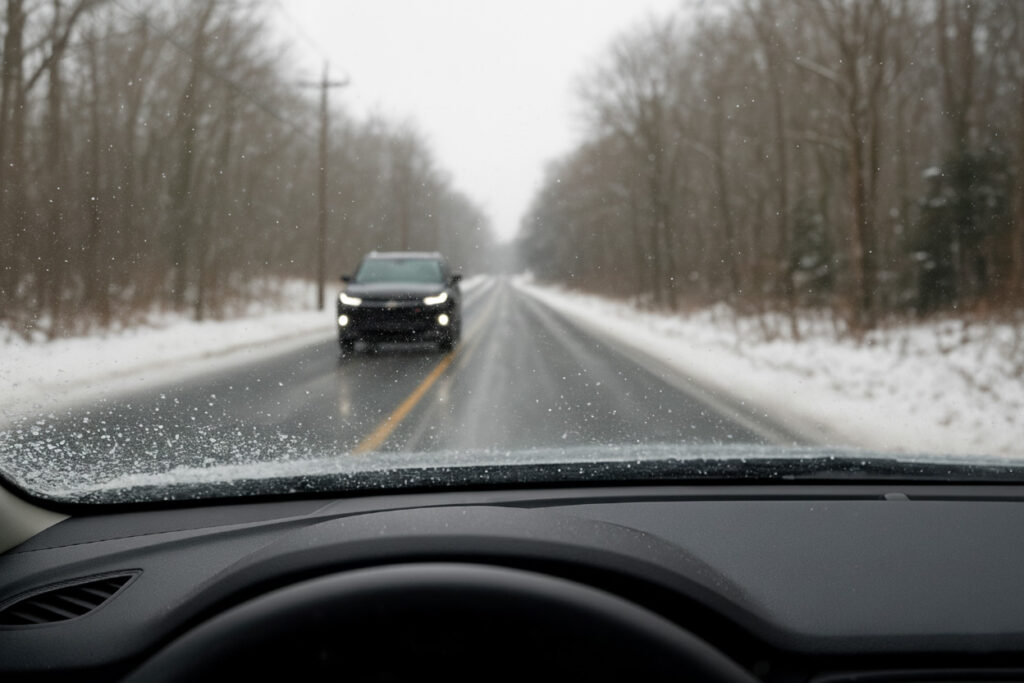Driving in the Northeast comes with some of the most beautiful scenery in the country, but the region’s unique climate and road conditions can be tough on your windshield. From harsh winters to busy highways, many hazards can weaken, chip, or crack your glass without warning.
This guide breaks down the most common windshield hazards in the Northeast, why they matter, and what you can do to stay protected.
1. Road Salt and Winter Debris
Snow and ice control involves heavy use of road salt, sand, and gravel across states like New York, Massachusetts, Pennsylvania, and Maine. While these materials help improve traction, they also create two major hazards:
Flying Debris
Cars in front of you can kick up pieces of rock or coarse sand. Even a single impact at highway speeds can cause a chip that later spreads into a long crack.
Corrosive Salt Residue
Salt itself does not usually crack glass, but it can cling to your windshield and wipers. Over time, this grit causes tiny scratches that scatter light, reduce clarity, and increase glare.
How to protect your windshield:
Keep a safe following distance, especially behind snowplows or trucks. Wash your windshield regularly and replace worn wiper blades before winter hits.
2. Freeze Thaw Cycles
The Northeast is known for rapid temperature swings. Water that seeps into an existing chip can freeze overnight, expand, and turn a small flaw into a large crack.
This pattern is especially common in:
- New Hampshire
- Vermont
- Northern New York
- Pennsylvania mountain regions
Tip: If you notice a chip, repair it right away. Small chips often cost far less to fix than a full windshield replacement.
3. Potholes and Rough Roads
Winter moisture, freezing temperatures, and heavy traffic create potholes across the Northeast every year. While potholes can damage tires and suspension, they also create windshield stress.
How potholes affect your windshield
When you hit a pothole, your vehicle experiences a sudden jolt that travels through the frame. If your windshield already has a small chip or any structural weakness, this vibration can cause it to crack instantly.
Prevention: Slow down in known trouble areas and avoid tailgating so you can maneuver around hazards.
4. Tree Debris on Rural and Suburban Roads
The Northeast has dense forests and tree-lined streets where falling debris is common, especially during storms. Hazards include:
- Branches
- Acorns
- Pine cones
- Broken limbs during high winds
Storms and nor’easters increase the likelihood of debris falling directly onto your windshield.
What to do: When storms are forecasted, avoid parking under trees and try to find covered or sheltered parking if possible.
5. Ice Scrapers and Deicing Mistakes
Icy mornings are a part of life in the Northeast, but how you remove ice matters. Many drivers accidentally damage their windshield by:
- Using metal scrapers
- Pouring hot water on ice
- Chipping ice too aggressively
These actions can scratch or even crack the glass.
Safer methods include:
- Using a plastic scraper
- Letting your defroster run
- Using deicer spray
- Starting with gentle strokes instead of forceful scraping
6. Temperature Extremes and Sudden Changes
Northeastern winters bring frigid nights and heated cabins. That difference in temperature between the inside and outside of your windshield can cause stress cracks.
This is especially common when:
- You blast the defroster on high heat
- You use a remote starter while the windshield is frozen
- You go from subzero temperatures into a warm garage
Tip: Warm your windshield gradually instead of shocking it with high heat.
7. Highway Traffic and Construction Zones
Busy corridors like I 95, I 90, I 80, and I 84 are known for heavy truck traffic. Trucks can throw debris into your path or generate turbulence that pulls loose material off the shoulder and into the air.
Construction zones also increase risk with loose gravel and uneven pavement.
Recommendation: Reduce speed, avoid driving directly behind dump trucks, and look for “Stay Back” warnings that indicate high debris risk.
8. Wildlife Collisions and Sudden Stops
The Northeast has high rates of deer and wildlife activity, especially in rural parts of:
- Pennsylvania
- New Jersey
- Connecticut
- Upstate New York
A wildlife collision can completely shatter your front glass, and even a hard sudden stop can worsen any existing windshield damage.
Tip: Use high beams on dark rural roads when safe and drive cautiously at dawn and dusk.
When to Repair or Replace Your Windshield
Not all windshield damage is immediately dangerous, but some types require immediate attention:
- Cracks longer than 6 inches
- Chips that obstruct your line of sight
- Damage near the edges of the glass
- Spidering or multiple chips from winter debris
Delaying repairs increases the chance of a full replacement and may also affect ADAS sensors if your vehicle has lane assist, forward collision warning, or a front camera.
Use Glass.net to Compare Local Shops and Prices
If you have windshield damage, Glass.net makes it easy to compare up to three trusted auto glass shops in your area. You can get instant quotes, check reviews, and find mobile or in-shop service options.
A quick quote can help you choose the best price and the most reliable provider for your needs.

To read more, visit blog.glass.net

